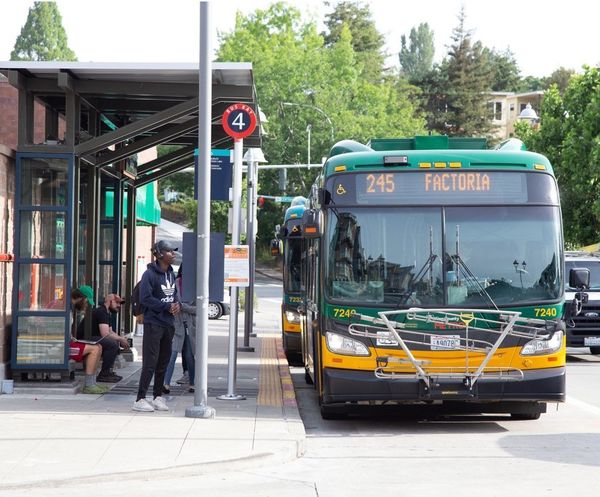
Key Takeaways
- People who were provided fully subsidized fares used the King County Metro transit system at double the rate than those who received only a partially subsidized fare.
- Riders leveraging fully subsidized fares did not overwhelm the transit system at peak travel times.
- Everyone who received fully subsidized fares, whether they had frequently or infrequently used the transit system prior to the study, used the transit system more often.
Mechanics
King County Metro Transit (Metro) is part of a large integrated regional transit system that offers a range of transportation options to a bustling county with a unique geography. Riders pay a flat fare of $2.75 on Metro buses, regardless of day or time, distance traveled, or time spent aboard. To make transit services more affordable and accessible for all King County residents, Metro launched the ORCA LIFT program, which reduced fares to a flat rate of $1.50 per ride on buses and light rail for people with incomes at or below 200% of the federal poverty level.
However, Metro’s work with community stakeholders revealed a need for additional support for residents with the lowest incomes. So, Metro partnered with LEO to understand the effect that a fully subsidized fare program would have on low-income riders.
LEO’s first randomized controlled trial with King County Metro began in March 2019 and included 1,797 low-income Metro riders divided into two cohorts. The first cohort included enrollees from March to July 2019. Enrollment for the second cohort began in December 2019 and was intended to go through April 2020 but was interrupted by the beginning of the COVID-19 pandemic in March 2020.
Within each cohort, riders were randomly assigned to either the treatment or the control group. The treatment group received an ORCA LIFT card pre-loaded with up to 24 weeks of fully subsidized transit. The control group received an ORCA LIFT card pre-loaded with $10 worth of free transit, which is the standard card given to riders seeking public assistance. Participants completed a short intake questionnaire to determine their baseline transit habits. LEO researchers used the ORCA LIFT registry to connect administrative data with ORCA LIFT card boarding data and conducted follow-up surveys to determine how the fully subsidized fares impacted ridership outcomes.
What We Learned
Results of the ORCA LIFT study indicate that access to free transportation significantly increases ridership. People who received the fully subsidized fares used the bus system twice as often as those who received only the partially subsidized fare. This indicates that cost may be a critical barrier keeping low-income King County residents from using the Metro system, irrespective of age or race.
Importantly, researchers learned that access to fully subsidized fares cannot make up for the lack of physical public transportation stops in some neighborhoods. The positive effect of fully subsidized fares diminished in neighborhoods that had no bus stops.
The study also shows that increased access to fully subsidized fares does not seem to place any additional burden on the transit system. Even though ridership increased for the most frequent riders, as well as those who had little-to-no transit experience prior to enrolling in the study, results show that access to these fares increased ridership the most during off-peak hours and on routes that were not overly crowded to begin with.
Where We’re Going
The first ORCA LIFT study presents clear evidence that fully subsidizing public transportation costs for low-income individuals increases their use of the transit system and access to locations throughout King County. Still, we need to know more about how increased access to and use of public transportation helps people live their best lives. LEO is now evaluating the impact of fully subsidized fares on outcomes such as healthcare access, employment, and subjective well-being measures for those most in need. LEO is also conducting an evaluation of Metro’s fully subsidized fare program to determine the impact to those with very low incomes.
The fully subsidized pass program is a two-year pilot collaboration between Metro, Sound Transit, and social service agencies who assist with enrollment. As the region’s largest public transit agency, Metro leads the program’s design, implementation, and evaluation of the fully subsidized annual pass. Sound Transit, the region’s second-largest transit agency, has partnered with Metro, which allows people who hold the fully subsidized annual pass to, at no cost, ride on and transfer between all of the two agencies’ services across an extensive regional transit network, primarily Metro’s bus services and Sound Transit’s light rail services.
The fully subsidized pass is valid for one year from the date of issuance, regardless of whether the holder’s income or eligibility change. After one year, the pass holder must re-enroll and meet eligibility criteria again to continue to access fully subsidized transit. The fully subsidized pass is visually indistinguishable from the region’s other transit passes (known as ORCA passes) that are commonly used by residents who ride public transit.
Learn with us.